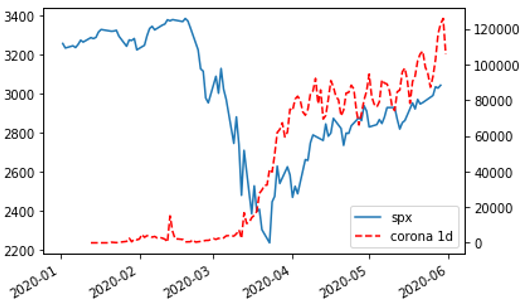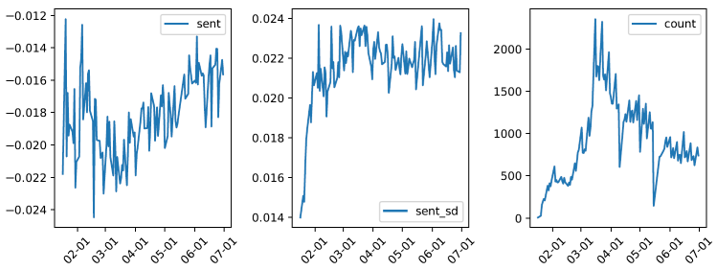From its February 2020 peak to a March 2020 trough, the S&P 500 index fell 34%. This fall was accompanied by extreme volatility, at a level last seen during the global crisis. Invariably the selloff was accompanied by media speculation about the onset of another Great Depression. However, the incidence of COVID-19 cases during most of this selloff was not yet at extreme levels, as shown in Figure 1, and the economic impact of the crisis was not yet evident.1
What drove this precipitous market decline? It was in part a rational anticipation of future COVID-19 cases and the associated impact on the economy and on society more generally. An article in the Wall Street Journal on 12 June 2020, for example, details a 31 January meeting where a medical expert from the Wellcome Trust warned investors that the upcoming health crisis would be surprisingly severe, with very negative impacts on supply chains and the travel industry. Ramelli and Wagner (2020), using a sector-level decomposition of stock price moves, argue that markets initially focused on the trade impact of the pandemic, also suggesting concerns about supply chains. Baker et al. (2020) argue that the unprecedented market reaction to the COVID-19 crisis is partially attributable to the economic impact of government-imposed commercial and travel restrictions. They downplay the role played by the information environment faced by investors.
Figure 1 S&P 500 index and the incidence of global COVID-19 case counts
Notes: This figure reports the S&P 500 index (spx) and incidence of global COVID-19 case counts (corona 1d), as reported by the Johns Hopkins COVID-19 dashboard.
In Mamaysky (2020), I argue that this information environment played a first-order role in markets’ crisis response. Innumerable headlines from the time of the selloff described market and economic conditions in dire terms. For example, one from the Washington Post stated on 9 March that “A market crash was coming, even before coronavirus,” in effect attributing the selloff to years of easy monetary policy. More negative headlines appeared in The New York Times, CNN, and other major news outlets. In February and March of 2020, hard data on the actual economic impact of the coronavirus pandemic was not yet available. What was tragically apparent, however, was the enormous human toll of the pandemic. This is what journalists covered. At the same time, journalists extrapolated from the tragic human dimension of the crisis to speculate about future disastrous economic consequences and associated negative impacts on corporate profitability. For the most part, these latter concerns about corporate profitability would prove unfounded. But investors paid attention. They meaningfully revised down beliefs about future cash flows. Markets experienced a steep, though short-lived, decline.
Figure 2 Word clouds associated with the credit and sports topics
To explore this information mechanism, I analyse how news flow interacts with five market indices: the S&P 500, the VIX volatility index, an index tracking the performance of high-yield bonds, and the two-year and ten-year Treasury yields. News flow measures are obtained from the 106,137 Reuters news articles that mention the terms ‘coronavirus’ or ‘COVID-19’ between 17 January and the end of June 2020.2 From this corpus, I derive 14 measures of news coverage surrounding the coronavirus pandemic. Twelve of these decompose the sentiment of news coverage into specific topics, such as news about credit markets, news about sports, or news about the health impact of the disease. Figure 2 shows the word clouds associated with the credit and sports topics. The two remaining measures are aggregate news sentiment and the standard deviation of sentiment across all news stories written in each day. Figure 3 shows that aggregate news sentiment bottomed around the middle of March and has steadily improved since then. The standard deviation of cross-sectional sentiment of coronavirus-related articles increased heading into February and has stayed high since. The number of coronavirus-related articles peaked in March, at over 2,000 articles per day, and has steadily declined since then. These sentiment and article count series have low frequency variation reminiscent of the various economic uncertainty measures reported in Altig et al. (2020).
Figure 3 Volume and sentiment of coronavirus articles
Notes: The left panel shows the daily aggregate news sentiment in all articles mentioning ‘coronavirus’ or ‘COVID-19’ and carried by the Reuters news service in January through June of 2020. Article-level sentiment is defined as the number of positive minus the number of negative words (using Loughran and McDonald 2011), divided by the number of total words in a news story. The middle panel shows the standard deviation of cross-sectional sentiment. The right panel shows the daily article counts.
In Table 1, I check which of the five market indices and 14 news series predict future COVID-19 case counts. I find that all five market indices are highly correlated with the number of cases that occur two to four weeks in the future, thus confirming that markets are forward looking, even during periods of extreme volatility. However, the market series are correlated with future case incidence only in the earlier parts of the sample; by early April market moves are no longer anticipatory of future case incidence. I also find that several of the news measures anticipate future case counts. For example, news about central banks, credit markets, the corporate and government sectors, and sports are all highly correlated with case incidence up to a month in the future. Other news series, however, are uninformative about future case incidence.
Table 1 Correlations between market and news variables and COVID-19 case counts
Notes: This table shows correlations between lagged market and news variables and future daily COVID-19 case counts. The time window over which this correlation is calculated runs from 17 January 2020 to end date, End , and is calculated over all lags from 1 to 21 business days in each window. The table reports the End and Lag at which the absolute value of the correlation is maximised for each test variable.
I then study the contemporaneous relationship between markets and news. In the early part of the sample, markets are very sensitive to contemporaneous news. Negative news is strongly related to lower market prices, and higher VIX. However, markets are more sensitive to uninformative news about future cases than to informative news. News related to markets, health, Europe, and aggregate news sentiment all drive contemporaneous market responses yet prove to be inaccurate about future case incidence. I calculate two versions of a Cochrane-Piazzesi (2005) style news factor that has maximum explanatory power for contemporaneous returns across all five markets.3 As Table 1 shows, the linear combination of the 14 news series (labelled factor and factor_all) that are most associated with contemporaneous returns across all markets have very low predictive power for future case incidence. The news that drove markets were not the news that predicted future disease progression. Furthermore, I document that markets react more to news, even uninformative news, on days of high market volatility. This is volatility for volatility’s sake, a phenomenon I call hypersensitivity.
I also investigate how day-t market action affects day t+1 news, and vice versa. In the early part of the sample, markets and day-ahead news are tightly connected. Lower market prices today prompt negative news the following day across most of my news measures.4 Figure 4 shows the network of relationship between day t+1 news and day t market prices. Tomorrow’s bad news, as I have already shown, then leads to lower markets tomorrow, which in turn causes bad news the day after tomorrow. The markets-news cycle thus amplifies negative shocks. At the same time, day t news predicts (Granger causes) day t+1 market price action but very frequently in the direction opposite to the contemporaneous market response. Thus, a piece of news that causes lower market returns today often predicts a move tomorrow that either fully or partially reverses the contemporaneous market response. This is evidence of market overreaction to contemporaneous news.
Figure 4 Granger causality network of market returns and news measures
Notes: Granger causality network of day t market returns to day t+1 moves in the subsample through 15 March. A solid, blue (red, dashed) arrow indicates positive returns on day t forecast an increase (decrease) in the day t+1 news measure.
Using the Andrews (1993, 2003) distribution for the maximal Chow statistic, I document that the markets-news relationship undergoes a structural break in the middle of March. Figure 5 shows that the optimal break date (the one with the highest Chow F-test) for almost all news-markets pair occurs in March, with the majority of break dates bookending two major Fed announcements that took place on 15 March and 23 March. Furthermore, the majority of optimal break dates are statistically significant according to the Andrews (1993, 2003) distribution. Based on the results of the structural break tests, I divide my sample into two halves: before and after 15 March.5 The results discussed thus far apply to the early subsample.
In the late (post- 15 March) subsample, the hypersensitivity and overreaction of markets stop and are replaced by a more ‘normal’ markets-news regime that prevails from mid-March to the end of June. In the late subsample, markets are more sensitive to news that prove to be accurate about future disease incidence, and there is much less evidence of either hypersensitivity or overreaction. It is likely that a robust monetary policy response caused the structural break, which suggests an additional channel for how central banks can influence markets: Strong monetary policy response can push the markets-news equilibrium from a stressed to a more normal state.
Figure 5 Structural break tests for all news-market pairs
Notes: The figure shows the results of structural break tests for all news-markets pairs. The news series include the 14 series already described, and contemporaneous COVID-19 counts.
Aspects of the markets-news relationship during the COVID-19 crisis can be explained by the theoretical analysis in Glasserman et al. (2020), who argue that extreme media scrutiny can push markets into a high-volatility, low-price state, which in turn invites more media scrutiny. In the model, such states are characterised by prices that are extremely sensitive to fundamentals and that have high risk premia. Part of the markets’ response to the global coronavirus pandemic appears to stem from this kind of news-induced extreme sensitivity, apparently an unintended consequence of a highly active news sector.
References
Altig, D, S Baker, J Barrero, N Bloom, P Bunn, S Chen, S Davis, J Leather, B Meyer, E Mihaylov, P Mizen, N Parker, T Renault, P Smietanka and G Thwaites (2020), “Economic uncertainty in the wake of the COVID-19 pandemic”, VoxEU.org, 24 July.
Andrews, D (1993), “Tests for parameter instability and structural change with unknown change point”, Econometrica 61(4): 821-856.
Andrews, D (2003), “Tests for parameter instability and structural change with unknown change point: A corrigendum”, Econometrica 71(1): 395-397.
Baker, S, N Bloom, S Davis, K Kost, M Sammon and T Viratyosin (2020), “The unprecedented stock market reaction to COVID-19”, Covid Economics, 1, 33-42.
Cochrane, J and M Piazzesi (2005), “Bond risk premia”, American Economic Review 95(1): 138-160.
Glasserman, P, H Mamaysky and Y. Shen (2020), “Dynamic information regimes in financial markets,” working paper.
Loughran, T and B McDonald (2011), “When is a liability not a liability? Textual analysis, dictionaries, and 10-Ks”, Journal of Finance 66: 35-65.
Mamaysky, H (2020), “Financial markets and news about the coronavirus”, Covid Economics 38: 68-128.
Ramelli, S and A Wagner (2020), “What the stock market tells us about the consequences of COVID-19”, in R Baldwin and B Weder di Mauro (eds.), Mitigating the COVID Economic Crisis: Act Fast and Do Whatever It Takes, a VoxEU.org eBook, CEPR Press.
Endnotes
1 For example, the year-over-year change in US industrial production was not meaningfully impacted until the end of March, and this information was not available to market participants during the February-March selloff.
2 The present column updates the results in Mamaysky (2020), which uses data only through April 2020.
3 I first run a pooled regression of normalized returns across all five markets, with the VIX index changes multiplied by -1, on all 14 news series. Then I use the fitted values from this regression as factor_all. To obtain factor, I re-estimate pooled regressions in the early and late subsamples separately and merge the two fitted series.
4 In the statistical sense of Granger causality.
5 Setting the sample break date equal to the optimal break date for each markets-news pair leaves all results qualitatively unchanged, though perhaps even stronger than the reported results.










